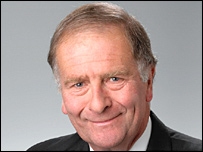Turncoat
Ten days before the May 2010 general election, Roger Gale wrote "I have never supported night flights from Manston and do not propose to do so." Click here to see for yourself. Six months later, he writes this...
Gale's View – 22 October, 2010
East Kent will, very shortly, have the opportunity to indicate clearly whether we want the airport at Manston, and the jobs and transport links that are dependent upon it, to have the opportunity to grow and prosper or to close.
We need, I think, to be very clear that the consultation relating to night time aircraft movements, due to be independently carried out for Thanet District Council in response to an application by the airport operators, Infratil, will affect the whole future of aviation at Manston and, very possibly, in the South East.
Ask local people if they want to be able to fly to sunshine holiday destinations direct from Manston and the answer is an emphatic “yes”. Ask the same people if they want to see more freight flights from the same airport and the response is, not surprisingly, very much more restrained. We subscribe to development that benefits us personally and we are lukewarm about development, whether it be business, retail or even housing, that impacts adversely upon our lives.
The harsh economic fact is that for the foreseeable future Manston cannot survive without freight traffic and the competition for a dwindling share of that freight market is fierce. Long-haul passenger flights into Heathrow, Gatwick and Stansted carry considerable amounts of belly cargo and other regional airports, such as Ostend, are able to offer highly advantageous terms, conditions, costs and hours of movement. Remove the flexibility from Manston and the essential services – Air Traffic Control, Fire vehicles, Revenue and Customs, Re-fuelling and even catering, become unsustainable. Without those services the airfield will close.
There is, of course, no guarantee that the present operators will prove any more successful than predecessors dating back to the original civilian proprietors, Seabourne Aviation. Current passenger trends using Flybe services to Edinburgh and Manchester are modestly encouraging and the prospect of some Sunshine Destination tour operators is, as always, on the cards. The possibility of bringing aircraft carrying the overseas 2012 Olympic and Paralympic teams directly into Kent is enticing also. These are too few swallows, though, to make a summer and it is clear that the need to attract and retain freight operators is vital to Manston's survival.
We also have to recognise that without Manston not only will the airfield's job creating potential disappear but so, also, will any serious justification for a parkway station or the extension of the fast rail link from Ashford through to Thanet. That prospect may please those whose self-interest reflects only a demand for tranquillity but it would not bode well for future generations seeking to work and raise families in East Kent.
I have consistently opposed a free-for-all night flying policy that has been espoused, in the past, by some of Thanet`s councillors of both major political persuasions. I do, however, believe that the proposals now on the table represent a fair consideration of the airport`s likely maximum night time flexibility through to 2018 and very possibly beyond. To represent the maximum unit quota provided for in the application as “Seven night flights per night” is mischievous if not downright dishonest. Even local journalists living on the flight path need to recognise that the purpose of the unit quota is to limit and regulate night time noise. If, though, we deny the operators the operational flexibility needed to accommodate not only scheduled aircraft movements but also the unforeseen late take-offs from overseas destinations that, inevitably, affect arrival times then we shall drive Manston's business across the Channel with the inevitable consequences.
Thanet Council has indicated very clearly that it will take no decisions until the outcome of the consultation is known. That is a correct and proper position. It is also entirely right that those of us with elected responsibility should do everything possible to both recognise the legitimate needs of a potentially valuable local business while at the same time seeking to mitigate any environmental impact upon residents and the countryside that may arise from those needs.
If, however, a relatively few of East Kent's residents are left with an open goal into which they may then kick “anti-airport” shots then we shall be doing the future of East Kent no favours at all. Those that want Manston (and, of course, the remaining RAF presence as well) to close have a clear duty to indicate what alternative future (Industrial development? Housing Estates?) they see for the land, what vision they have for the future of local transport infrastructure and how they intend to generate the employment opportunities that East Kent's children and grandchildren will be looking for. Protest-power without social responsibility is no more of an acceptable or honest position that would be the free-for-all night aircraft movement policy that absolutely nobody is in fact proposing.
You can contact Roger Gale at: suzy@galemail.com
Parsons Brinckerhoff (PB) put Manston’s request in the context of increasing demand for aviation services, particularly in the south-east of England:
 No Night Flights home page
No Night Flights home page

